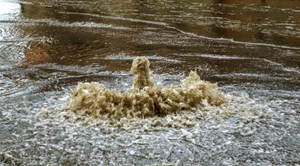Signal Mountain, Tenn., plans $40 million sewer upgrade to address overflow issue
TENNESSEE (UI) — At a Signal Mountain Council meeting, officials revealed that Signal Mountain's sewer system, comprising just 8.2% of the overall system maintained by the Water and Wastewater Treatment Authority (WWTA), is responsible for a staggering 71% of overflows.
To address this issue, the WWTA presented a $40 million plan aimed at providing relief, the Chattanoogan reported.
According to the Chattanoogan, sewage overflows are not only evident at manholes, but more problematically, they also happen within the numerous creeks and tributaries leading to these manholes.
The reason for this lies in the construction of the sewer system in Signal Mountain, where half a century ago wastewater-carrying pipes were often placed within stream beds, taking advantage of gravity's downward pull. Consequently, during periods of rainfall, the creeks experience significant E. coli contamination due to the overflows.
According to Eric Brooks, the WWTA chief engineer, the contaminated water eventually clears itself after approximately 48 hours, and E. coli tests return negative results. However, the worrisome part is that the polluted water ultimately makes its way into the Tennessee River.
For five decades, Signal Mountain has dealt with sewage issues primarily caused by the location of its pipes, which are riddled with cracks and breaks both in the streams and underground. This complicates the remediation process due to the underlying rock.
To address the problem, the Water and Wastewater Treatment Authority (WWTA) is bound by a consent decree compelling them to prevent contaminated water from reaching the Tennessee River. The WWTA’s goal is to minimize inflow and infiltration, as well as eradicate sanitary sewer overflows.
Failure to tackle these issues could result in federal government intervention, potentially reducing the city’s influence over the process compared to WWTA's involvement. To keep residents informed and involved, WWTA is organizing public meetings where they present their cleanup plans and welcome comments.
During a recent town council meeting, Brooks and Neeley Langham from Jacobs Engineering unveiled the comprehensive plan designed to rectify the water contamination problems and bring Signal Mountain in line with state and federal regulations.
A sewage transportation system has been devised to relocate the sewage currently running through the pipes in Shoal Creek within Green Gorge Park, along with other waterways. This plan involves directing the wastewater to two pumping stations strategically positioned at the park's edges.
The chosen locations were determined based on gravity considerations and to minimize any disruptions to the park's natural environment. One of the pumping stations, the Druid Road pump station, will be situated on Green Gorge Road between Fern Trail and Druid Road, while the other, the Ravine Road pump station, is planned for Ravine Road near Whippoorwill Drive.
As the property for the Ravine Road site is owned by the town, WWTA will require an easement to construct the station there. According to the council and public, there are no viable alternative locations due to the challenging terrain, topography, and substantial rock formations. Consequently, the old pipes and manholes will be abandoned.
WWTA Executive Director Mike Patrick clarified that the 50x70-foot facilities will be distinct from others in the area, primarily due to aesthetic considerations rather than groundbreaking technology. The difference lies in their design, which aims to seamlessly blend with the appearance of the existing neighborhoods, potentially incorporating features such as fencing or walls. As of now, the designs for these facilities are yet to be finalized.
The initial phase of the project involves the installation of pump stations. Another aspect of the plan includes implementing low-pressure pumps in areas with high infiltration and inflow of ground and stormwater into the pipes. For this, grinder pumps will be placed at individual households, which will effectively grind up the sewage and pump it to the sewer mains in the street.
This system has already been successfully employed in Lookout Mountain, Georgia, for an extended period. In the current project, 37 houses in one neighborhood and 208 homes in another will require the installation of these grinder pumps. To maintain an aesthetically pleasing appearance, the pumps can be camouflaged with an artificial boulder or a green disk that lies flat on the ground. The responsibility for maintaining this system will fall under the jurisdiction of WWTA.
The third phase of the plan will focus on the rehabilitation of broken pipes using liners. These broken and cracked pipes are the main points through which excess water infiltrates and overwhelms the sewer system. By addressing these issues, the overall efficiency and effectiveness of the sewage system can be significantly improved.
The Water and Wastewater Treatment Authority (WWTA) primarily funds the maintenance and repairs of the sewer system through sewer bills. If WWTA fails to address the problems, it may face fines and subsequently pass the costs on to its customers.
However, funds from the American Rescue Plan Act are available for this project. These funds can be used for water and sewer infrastructure, but there is a condition that they must be obligated by the end of December 2024 and spent by December 31, 2026.
Related News
From Archive

- OSHA cites Florida contractors for trench safety violations at sewer and excavation sites
- Biden-Harris administration invests $849 million in aging water infrastructure, drought resilience
- Texas contractor penalized by OSHA for repeated trench safety violations
- West Virginia approves $67 million for water, sewer projects
- Mark Boyer named 2025 MVP of underground infrastructure industry




Comments